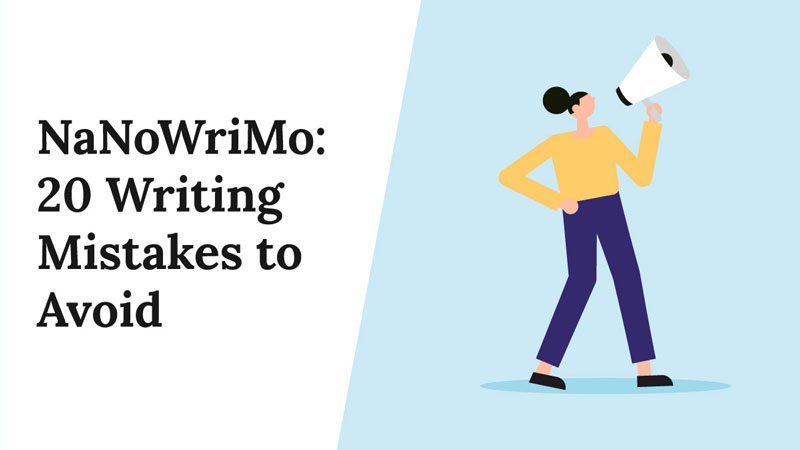NaNoWriMo is a popular program that many writers turn to for a chance to flex their noveling muscles. They accept the challenge to write like the wind in an attempt to pump out 50k words in a single month, but do they know about NNaNoEdMo
NaNoEdMo is a lesser known extension of NaNoWriMo. It encourages writers to take on an editing challenge that is laid out in much the same way. NaNoWriMo itself discourages editing throughout the month of November. This is simply to help writers get their word count finished. Of course, no novel will ever be complete without a few rounds of editing. This is where NaNoEdMo comes in: it stands for National Novel Editing Month and takes place in March.
How Does NaNoEdMo Work?
NaNoEdMo operates on a similar structure as NaNoWriMo. It happens every year at the same time – for the month of March. NaNoWriMo sets a goal of 50,000 words written in November. NaNoEdMo follows the same theme, challenging writers to spend a total of 50 hours editing in a single month. Any additional novel planning, outlining, or researching doesn’t count towards this goal – it is for editing only.
While the challenge is directly connected to NaNoWriMo, you can theoretically work on anything. Editing and rewriting your NaNoWriMo project is the most natural progression, but it doesn’t have to be. March is only three months after NaNoWriMo, maybe you’re still sick of your Nano novel! Or perhaps you hated it so much that you destroyed every shred of evidence that it ever existed. If this happens to be the case, you can pick any work in progress to edit during NaNoEdMo.
NaNoEdMo History
NaNoWriMo has grown and evolved quite a bit over the years, but it officially began in 1999. NaNoEdMo was founded a few years later in 2003 but only ran until 2006 when the founders moved onto to other projects. It began at Nanoedmo.org, where it gained a decent following in only three years.
Officially, it was no more, but a group of dedicated NaNoWriMo participants decided to revive it in time for the 2007 edition. They recreated the event at Nanoedmo.net, which was active until 2013. 2014 had NaNoEdMo on hiatus, but it was once again resurrected the next year at Nanoedmo.com, where it has been running every year since.
The event is entirely volunteer-based, and like NaNoWriMo, is completely free to participate in.
NaNoEdMo Website
The NaNoEdMo website is minimal and simplistic but sufficient for those wishing to be active in the community during the event. Large amounts of editing can be tough work, and having a circle of support can be extremely beneficial.
Writer Profiles
When you sign up to the website, you can create a small profile for yourself. The profiles are brief and simple, but enough to get the basics on your fellow editors. You have the option of uploading a profile picture – but this is, of course, not necessary. You can also add details such as:
- Your real name.
- Your location (as vague or specific as you want).
- Your current project.
- How long you have been doing NaNoEdMo.
- How long you have been doing NaNoWriMo.
- A small blurb about yourself in the “about me” section.
Forums
For those who want to get even more connected, there is a series of forums for you to explore. The NaNoEdMo forums are not as large and comprehensive as NaNoWriMo’s, but there are still some good conversations happening. There is a place for writers to discuss their specific projects, a section for editing help, as well as an off-topic thread for more general chit-chat.
Live Chat Room
If you don’t want to participate in any of the site-wide conversations, you can be a little more personal in the live chat room. This is an instant messaging chat box where anyone who is online can participate. This can be a fun way to get to know people on a more intimate level and talk about anything and everything that may come up.
Twitter Feed
Many wrimos take to Twitter during November for support, word sprints, and community. NaNoEdMo is much the same, with an active Twitter account of its own. The account has a feed that provides encouragement and shares resources. It also posts funny memes for some much-needed comic relief. The posts from this account are integrated right onto the NaNoEdMo website so you can see all the content from the same place if you wish.
The Importance of NaNoEdMo
While the original founders of NaNoEdMo did not remain invested in the concept for very long, they knew what they were doing. There is no doubt that NaNoWriMo is amazing in many ways. It has become a huge international event that helps thousands of writers.
Once November ends though, many people neglect to continue their efforts. NaNoWriMo does have other initiatives that run throughout the year. These do provide many good resources, but there needs to be an emphasis on editing. NaNoEdMo is that emphasis, and it is very important.
Thorough and extensive editing is essential to any novel that makes it to the end of the publishing process – but proper editing can be difficult. Whether you have edited 20 novels, or you are attempting your first, it is always helpful to have a community at your side. Effective editing takes practice, and NaNoEdMo is a place for writers to share tips, tricks, and advice.
Being heavily affiliated with NaNoWriMo also ensures that writers have something in common. They have come from the same place and gone through the same insanity that is writing an entire novel in a single month. They understand each other and will be able to help each other in the best way possible.
Get Organized for NaNoEdMo
Everybody has a different process, but if you are a writer who loves to plan and outline, there are some programs out there that you may find useful. Something sleek and modern like Squibler will help you research, brainstorm, and plan your novel all in one place.
It has a spot to store and categorize your notes. It also allows you to organize your manuscript into scenes and chapters that can be rearranged with ease. This structure will help you finish your first draft faster. Having everything so precisely organized will improve the efficiency of your editing process.
You can edit chapters individually, and jump around as much as you like. You don’t have to work in chronological order. If you decide that a particular scene would be better in a different spot within the story, simply drag and drop it into place!
NaNoEdMo Editing Tips
There are some general editing tips that are good to have in your toolbox before you take the plunge into the annual March editing madness.
Give your Story Some Space
Once you have completed your first draft, consider taking a short break from it before starting the editing process. As much as you may love the story, no novel is written free from frustration and obstacles. Give your brain a breather and step away for a time – at least a few days, or perhaps a few weeks is what you need. This will allow you to approach your editing with a mind that is rested and refreshed.
One Type at a Time
When editing, there will be many different things that you are looking for. It is wise to approach each of these separately and tackle them on their own. Some of the “types” of editing you will do include:
- Typos
- Plot
- Characters
- Pacing
- Scenes
Separate these elements and go through them one at a time. This may be tedious, but it will help you remain focused. Doing too many things at once will cause mistakes to be missed, and frustration to be felt.
Read it out Loud
Reading your work out loud is an effective way to catch things. Hearing the words being read out loud will make clunky, awkward sentences glaringly obvious. More often than not, it is easier to hear a run on sentence than to read it in your head. When hearing the rhythm audibly, placing that missing comma will be easier.
Use Apps to your Advantage
The internet and its online communities are growing and evolving all the time. With this always comes new resources that are designed to make content better and life easier. There are apps and programs out there that can assist you in almost every part of the editing process.
Catch simple grammatical and spelling errors with Grammarly. Scan for readability and word choice with Hemingway. If these apps don’t suit your style, there are others! The internet is vast – take advantage! Editing is a long and arduous process, so don’t be ashamed of automating part of it and saving some time and effort.
Watch for Repeated Words
Most writers have a strong vocabulary. This is essential in writing pieces that are diverse and interesting. Despite this, most writers have certain words or phrases that are often overused. These are words that are easy to put into a sentence and don’t require much thought:
- Like
- Actually
- Also
- Basically/essentially
- Due to the fact that
- Honestly
- Just
- Very
These are only a few examples. Minimal use of these types of words is not too troubling, but do pay attention to these things and try to use a variety of alternatives where possible.
Confusing Words
In addition to words that get overused and repeated often, there are a number of words that are similar to each other. Many writers get confused and use the wrong version of the word:
- affect/effect
- further/farther
- can/may
- less/fewer
- that/who
- lay/lie
- then/than
- A lot/alot
- good/well
- who/whom
- it’s/its
- into/in to
Words like these are often used in the wrong way. It is understandably difficult as both spelling and meaning tend to be similar. Familiarize yourself with these problem words and their differences, and make a point to use them correctly the first time.
Get Someone Else to Read it
Whether you hire a professional editor or not, having someone else edit your work is crucial. Even if you have gone over it 100 times, a fresh set of eyes will always pick up on mistakes you missed. Even if the writing is perfect from a grammatical standpoint, hearing feedback on the story from the perspective of a reader can be helpful. They may be able to point out plot holes or make suggestions to improve the structure and flow.
Don’t Over Edit
It is possible to over edit your work. Many perfectionists will struggle with this, as will writers who are not confident in their abilities. The perfect novel does not exist. It is imperative that you remember this.
Don’t get caught up in the details and obsess over a single comma placement for a full hour. Don’t rewrite the same sentence 50 times, only to go back and rewrite it another 50 times the next day.
If you find yourself obsessing over certain parts of your novel, or never being satisfied with it, try taking a step back. It is true that a novel will require several rounds of editing before it is ready for publishing. This doesn’t mean it needs to be changed over and over again for the rest of time. Working with a professional will help you find the right balance in your editing. If you don’t want to go the route of professional editing, it is important to have that second set of eyes go over it.
Will you Take the Challenge?
You’ve done NaNoWriMo – you’ve written 50,000 words in a single month, and you’re ready to tell the world your story. The only problem is… your story kind of sucks. This is the reality for almost every NaNoWriMo project at the end of November, and that’s okay! The point of NaNoWriMo is not to write perfect words. The point is to write words.
At some point though, the words do need to be edited. So, will you take the NaNoEdMo challenge and dedicate 50 hours to your novel in March? It may just be the push your novel needs to ultimately end up on bookshelves worldwide.


![NaNoWriMo YWP [Complete Review]](/learn/wp-content/uploads/2021/12/nanowrimo-young-writers-program-ywp-11.jpg)
![What is Camp NaNoWriMo? [An Insider’s Review]](/learn/wp-content/uploads/2021/12/camp-nanowrimo1.jpg)








